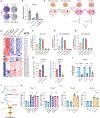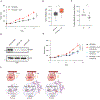Cancer-associated fibroblasts maintain critical pancreatic cancer cell lipid homeostasis in the tumor microenvironment
- PMID: 39535921
- PMCID: PMC11648993
- DOI: 10.1016/j.celrep.2024.114972
Cancer-associated fibroblasts maintain critical pancreatic cancer cell lipid homeostasis in the tumor microenvironment
Abstract
Pancreatic ductal adenocarcinoma (PDAC) is an aggressive malignancy with abundant cancer-associated fibroblasts (CAFs) creating hallmark desmoplasia that limits oxygen and nutrient delivery. This study explores the importance of lipid homeostasis under stress. Exogenous unsaturated lipids, rather than de novo synthesis, sustain PDAC cell viability by relieving endoplasmic reticulum (ER) stress under nutrient scarcity. Furthermore, CAFs are less hypoxic than adjacent malignant cells in vivo, nominating them as a potential source of unsaturated lipids. CAF-conditioned medium promotes PDAC cell survival upon nutrient and oxygen deprivation, an effect reversed by delipidation. Lysophosphatidylcholines (LPCs) are particularly enriched in CAF-conditioned medium and preferentially taken up by PDAC cells, where they are converted to phosphatidylcholine (PC) to sustain membrane integrity. Blocking LPC-to-PC conversion inhibits PDAC cell survival and increases ER stress. These findings show a critical lipid "cross-feeding" mechanism that promotes PDAC cell survival, offering a potential metabolic target for treatment.
Keywords: CP: Cancer; CP: Metabolism; fibroblasts; hypoxia; lipids; pancreatic cancer; tumor microenvironment; unsaturated fatty acids.
Copyright © 2024 The Authors. Published by Elsevier Inc. All rights reserved.
Conflict of interest statement
Declaration of interests The authors declare no competing interests.
Figures







References
-
- Lee KE, Spata M, Bayne LJ, Buza EL, Durham AC, Allman D, Vonderheide RH, and Simon MC (2016). Hif1α Deletion Reveals Pro-Neoplastic Function of B Cells in Pancreatic Neoplasia. Cancer Discov. 6, 256–269. 10.1158/2159-8290.cd-15-0822. - DOI - PMC - PubMed
Publication types
MeSH terms
Substances
Associated data
- Actions
Grants and funding
LinkOut - more resources
Full Text Sources
Medical
Molecular Biology Databases
Miscellaneous

